The Australian goldfields contrasted sharply with the masculinity myth that has lingered. Indelibly etched into the Australian pysche and part of a global epic is a goldfields full of men where women were strangely absent. Samuel Thomas Gill drew and painted what he saw on the goldfields and his illustrations and paintings depict women.
There was little written about women in Australian historiography until the 1970s. Feminist history then emerged with the seminal works of Ann Summers Damned Whores & God's Police and Miriam Dixson's The Real Matilda with Beverley Kingston's My Wife, My Daughter and Poor MaryAnn following. Each was ground breaking in its own right. Other authors and historians, Joy Damousi, Kay Daniels, Jill Julius Matthews, Diane Kirkby, Kay Saunders, Patricia Grimshaw, Judith Smart, and Shurlee Swain, (to mention but a few) by using a diverse range of methodologies, themes and approaches added more women to the national story.
The compilation of names found here includes women from goldfields and smaller diggings around Victoria. Information about some of these women and places will be scarce, as they will have disappeared from our conscious sphere or geographical and historical knowledge. It is important to record them no matter how little we know.
Women are notoriously difficult to research in the early goldfields period. Often they use their husband's name, or their maiden surname. If widowed or separated, and they marry or cohabit again, they usually use their second husband's name or the name of the person with whom they are cohabiting. The research can be quite daunting and confusing! In all cases I have attempted to record all names used by a woman. There may be multiple entries referring back to the original entry or source of information.
*** PLEASE NOTE: I have transcribed some inquests and articles as they have been written. The content in some of these historical documents is sometimes of an extremely sensitive, graphic, and intimate nature. The use of some words may appear inappropriate in the current climate of political correctness, but I have felt it is necessary, in fact true, to historical fact to have transcribed unchanged what has been written. I apologise for any concerns that this may raise or that may occur.
Please contact me if you have information or images you would like included in this collection of biographies of goldfields women. I would be delighted to hear from you.
Every scrap of information adds to the completeness of the story. These are the stories of women on the goldfields.
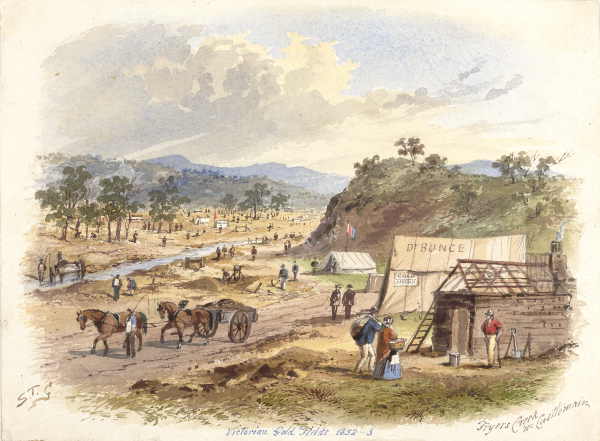

The Women
Surnames are listed under the letter that they begin with. Z is Maryann ZAHNLEITER
- All
- A
- B
- C
- D
- E
- F
- G
- H
- J
- K
- L
- M
- Mc
- N
- O
- P
- R
- S
- T
- U
- V
- W
- Y
- Z
Articles, Book Chapters & Academic
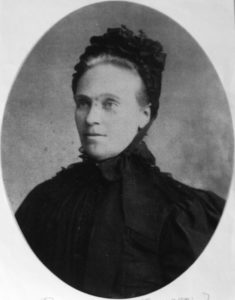 Dorothy Wickham, 'Blood, Sweat and Tears': Women of Eureka
Dorothy Wickham, 'Blood, Sweat and Tears': Women of Eureka
Published in the Journal of Australian Colonial History, pp. 99-115, University of New England, 2008. (peer reviewed)
William Bramwell Withers, in his History of Ballarat (1870), described the early goldfields as 'womanless crowds' wrestling 'with the earth and forest amid much weariness and solitude of heart'. The appearance of a woman 'was the signal for a cry and a gathering'. Certainly, women appear invisible where the key actions surrounding Eureka are concerned. It was the men who spoke at the 'Monster Meetings', who moved and seconded the motions of the Ballaarat Reform League, and who solemnly knelt and swore to stand by each other to defend their rights and liberties. ... This chapter reveals some of the hidden history of women at Eureka, in order to seek their inclusion in the popular understandings of this critical event. My work furthers the many recent attempts to include women in the Eureka story, notably by historians such as Clare Wright and Susan Kruss. I offer this as a contribution to a fuller understanding of the role and participation of women at Eureka, because to date only a partial story of Eureka has been told.
Dorothy Wickham, Silent Screams: The Hidden Agenda: Women in the Margins on the Goldfields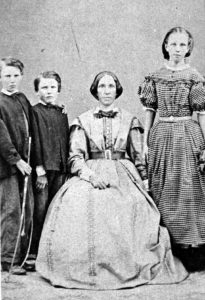
Published in Deeper Leads: New Approaches in Victorian Goldfields History, pp. 85-111, Keir Reeves & David Nichols (eds), 2007. (peer reviewed)
Abstract: Some European women exercised autonomous power on the early Victorian goldfields demonstrating their flexible gendered relations in the patriarchal colonial society operating. Some challenged orthodoxies, negotiated terms, faced adversities, and exercised agency in a goldfields landscape which was oriented to males. This chapter examines two marginal groups of women through the themes of marriage, family and the law.
...
Eliza Perrin, disclosed in letters to a cousin in England that she had run a business, bought a house, and accumulated money in the bank, ... Perrin was independent in nature writing to her cousin ‘it is entirely for yourself to choose whether you shall settle in England or come out here … I am sure you would like far better either to join me or have a place of your own like mine than to be confined to the stitching business’.
Perrin had decided to emigrate in 1853 to join her husband John on the Diggings, but on reaching Ballarat found that he was a drunken jealous man. She wrote ‘I was keeping a Refreshment House but he drank and destroyed all that I had’. Perrin devised with her ‘own endeavours’ to run a business to support herself and her three children while her husband was gold digging ‘up the country’ with his brothers. She ‘saved a little money’ and then ‘built a new house’ which cost her between ₤60 and ₤70. She wrote that this was ‘on the main Melbourne and Ballarrat [sic] road 10 miles from Ballarrat [sic] and I will take care that he never destroys this. He does not know that the house belongs to me or anything in it’.
The letters of January 1859 also revealed that Perrin was contemplating buying ‘2 or 3 acres of ground at the back’ of her Refreshment House and Store, rearing poultry, and fencing a garden. She commented that she could ‘hire a man for 15 shillings per week’ and he would pay her ‘better than a miserable husband’.
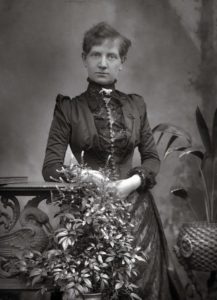 Dorothy Wickham, Not Just a Pretty Face: Women on the Victorian Goldfields
Dorothy Wickham, Not Just a Pretty Face: Women on the Victorian Goldfields
Published in Pay Dirt: Ballarat & Other Gold Towns, pp. 25-37, BHS Publishing, 2019. (peer reviewed)
Society of the mid 1800s was fiercely patriarchal where men controlled finances, wives and children. Under law men were legally responsible for their wives’ actions. If a woman divorced, or if she left the family home, her husband legally had sole rights to the children of that marriage. Due to the legal standing of femme covert many women essentially were enslaved in marriage. Many Victorian goldfields women maneuvered within such a patriarchal social construct, exercising agency. Some controlled their own finances, even if by law married women were not to enter into contracts. Others used their position in society to promote their status. The veiled hidden faces and the reality of of some of these women’s lives on the goldfields is here uncovered.
The strikingly beautiful Sarah Hanmer was young when she fell pregnant to accountant Frederick Ford. If we were to believe what was recorded on the Australian shipping lists, she was only fourteen years old when she went to Whitehall, Westminster to have her baby. Her determination is illustrated even in her early life when she kept her baby, a daughter she named Julia Ford. Sarah, an actress of some standing, was living in Bagnigge Wells, Clerkenwell near Saddler’s Wells theatre in 1844. Frederick Ford had married at Clerkenwell the year before. Julia carried his name, but no marriage can be found between her parents Sarah and Frederick.
In 1844 Sarah married comedian Henry Augustus Leicester Hanmer at St James, Clerkenwell. Sarah arrived in Ballarat in 1853 without her husband, but accompanied by her brother William McCullough and daughter, then known as Julia Ford Hanmer. Curiously Henry Augustus Leicester Hanmer, born 1811 at St Leonards, Shoreditch, London, married again in 1853. Perhaps the distance and communications between London and Melbourne saved him from a charge of bigamy. Sarah and her daughter were set to make a remarkable and significant contribution to the social fabric of one of Australia’s foremost goldfields towns.
PhD - WOMEN IN ‘BALLARAT’ 1851-1871: A CASE STUDY IN AGENCY
Dorothy Glennys Wickham M. Phil. (Australian Catholic University), T.P.T.C. (Ballarat)
School of Behavioural and Social Sciences and Humanities, by Research,
University of Ballarat, March 2008
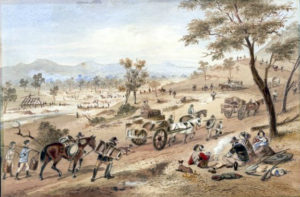
S. T. Gill. The Rush to Ballarat Goldfields 1854, National Library of Australia
Summary: This thesis demonstrates significant numbers of women were on the Ballarat goldfields from 1851 to 1871. Contrary to popular belief, many women exercised multifarious relationships of power. Through the broad themes of health, marriage, birth, death, family, law, philanthropy, work, enterprise and public protests this thesis highlights how women accepted, negotiated, manipulated, contested, and resisted socially accepted values and constructs upheld by colonial goldfields society. It highlights the fluidity in gendered roles and the complexity of colonial life and relationships.
Abstract: This thesis argues that European women exercised agency in mid nineteenth century Ballarat. It develops an understanding of women as active agents who engaged with, and negotiated, relationships of power. It highlights the fluidity in gendered roles, the blurred lines between the public and private domains, and the complexity of colonial life and relationships.
This social and feminist history situates women within the system of patriarchal power which systematically and overtly benefited men. It reveals the complex operation of patriarchal power in which women accepted, challenged, and resisted social values and constructs. Such a consideration of the structure of power dislodges the notion of women as oppressed bodies who passively accepted universal and monolithic patriarchal values, and instead highlights diversity within gendered power structures.
Drawing on public documentation, narrative, biographical, and statistical information from a diverse, extensive, and comprehensive range of archival sources, this thesis utilises a form of microhistorical methodology to detail and analyse the ways in which colonial women helped to shape society. It then draws a broader interpretation from such analysis to locate this thesis among other feminist and goldfields discourses.
Through the central themes of health, birth, death, marriage, family, law, religion, temperance, philanthropy, work and public protests, this study identifies strands of agency exercised by Ballarat’s colonial women during the city’s metamorphosis from the heady early days after the official discovery of payable gold in 1851 and the subsequent expansion of colonial settlement, to the consolidation of the City of Ballarat in 1871. Women predominantly acted as domesticating, nurturing and civilising agents, their actions deriving legitimacy from patriarchal values and endorsed by men. Women also contested, challenged, negotiated, manipulated, resisted and rejected socially accepted values, while playing out their lives within the colonial society in which they lived.
Master of Philosophy (MPhil)
BEYOND THE WALL: BALLARAT FEMALE REFUGE: A CASE STUDY IN MORAL AUTHORITY
Dorothy Glennys Wickham T.P.T.C. (Ballarat)
School of Arts and Sciences, Faculty of Arts and Sciences, Australian Catholic University, Office of Research, Fitzroy, Victoria, Australia. 7 January 2003.
Prelude
The Hopetoun day was hot and languid. Ten year old Thomas Ellis watched his toy boat float merrily in the waters of the local reservoir. His parents, the Wesleyan missioners, William and Sarah and his siblings, Eleanor and Fanny Pearl, were enjoying the lazy picnic. Suddenly, there was a cry as the small boy saw his boat being taken away in the current. His father ran to rescue the craft, but fell into the cold waters clutching his chest. His heart had ‘burst’ according to oral family history. Sarah was left with three small children to raise. The year was 1897 and she had already lost a young husband and a baby, the twin to Eleanor.
Sarah Jane Ellis became matron of the Ballarat Female Refuge and remained in that position until 1920, when she managed Warrawee, a private hospital in Victoria Street, Ballarat.
Sarah Jane was my maternal great grandmother and it was this family involvement that stirred an interest in the Ballarat Female Refuge. My childhood abounded with stories of the Refuge and my great grandmother walking the streets of Ballarat to attend to ‘poor’ girls’ confinements before she took over the position of matron at the Refuge. Many of my cousins and aunts were born ‘at the Refuge’. My relatives were also ‘inmates’ and workers of the Refuge, whilst one of the babies born at the Refuge, although not directly related to our family, was brought up as a brother to my mother.
This evidence I was privileged to was all anecdotal, family legend, and unsubstantiated. It was not until I began this project that I began to research ‘The Refuge’ seriously and methodically, and to wonder at the reasons for its existence.
Mick Trembath conceived The Memory Atlas, a project to capture and tell the personal histories of some of Ballarat's 'hidden' histories.
Caled Cluff writes that 'Among the Ballarat stories collected by Michael so far are some well-known names: Lynne Muller of the Ballarat Light Opera Company; historian Dorothy Wickham; Les Hardy of the Brown Hill Pipe Band.
The stories they reveal are deeply personal, compelling, often funny and always enlightening – how the BLOC provides costumes to other companies for shows, the battle to learn the intricate mysteries of the bagpipe, the hidden histories of a women’s refuge; how a young boy imagines the planets of the solar system as characters with personalities.'
Local historian Dot Wickham speaks about her personal connection to Ballarat's first women's refuge a NOTE: the address is actually 183 Scott Parade... NOT 187